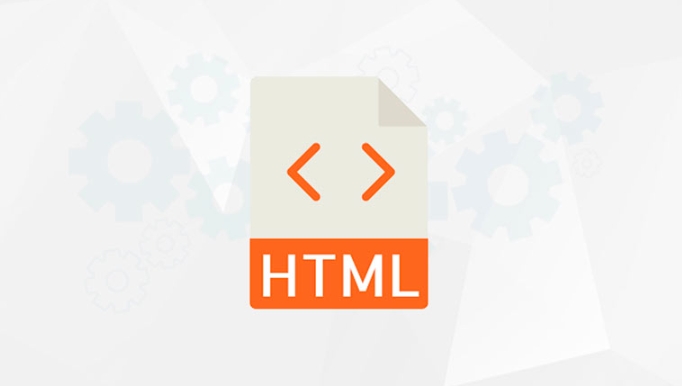HTML5 Drag and Drop API is a browser natively supported drag and drop function interface. 1. It controls the drag-and-drop process through events such as dragstart, drag, dragend, dragter, dragover, drop, dragleave, etc.; 2. When implementing, draggable="true" needs to be set and event handling functions are bound, such as setting data in dragstart, and data in drop is obtained; 3. Notes include: e.preventDefault() must be called in dragover to trigger drop, dataTransfer is used to pass data, and files are processed directly through FileList when dragging files. The default behavior of some browsers needs to be blocked, and cross-domain drag-and-drop may be subject to security restrictions. This API can be used in scenarios such as file upload, list sorting, etc., but you need to pay attention to compatibility and user experience issues.

HTML5's Drag and Drop API is a set of interfaces natively provided by the browser, allowing you to easily implement the drag and drop function of elements. You don't need to rely on third-party libraries, you can do it by using JavaScript and HTML. It is suitable for file upload, list sorting, component dragging and other scenarios.

Basic process of drag and drop
Drag and drop operations are actually a process composed of several events:
- dragstart : fired when the user starts dragging an element
- drag : Continuously triggered during dragging
- dragend : Triggered when the drag ends (whether it is drop or cancel)
- dragenter : Triggered when the dragged element enters the target area
- dragover : Continuously triggered when dragging within the target area
- drop : fired when the element is released in the target area
- dragleave : Triggered when the dragged element leaves the target area
You only need to bind the corresponding processing functions on these key nodes to control the entire drag-and-drop behavior. For example, set dragged data in dragstart , and handle data reception and logical execution in drop .

Implement a simple drag-and-drop example
Suppose you want to drag one div into another div, the most basic approach is:
<div id="draggable" draggable="true">Drag me to try</div>
<div id="droptarget">Put it here</div>
<script>
const draggable = document.getElementById('draggable');
const droptarget = document.getElementById('droptarget');
draggable.addEventListener('dragstart', function (e) {
e.dataTransfer.setData('text/plain', 'This is the dragged data');
});
droptarget.addEventListener('dragover', function (e) {
e.preventDefault(); // Default behavior must be blocked to trigger drop
});
droptarget.addEventListener('drop', function (e) {
e.preventDefault();
const data = e.dataTransfer.getData('text/plain');
console.log('Received data:', data);
});
</script>A few points to note:

- To make the element draggable,
draggable="true"must be added - In
dragover, be sure to calle.preventDefault(), otherwise the drop will not take effect -
dataTransferis an object used to pass data, supports multiple formats, and commonly used text
Frequently Asked Questions and Notes
When using this API, some details are easy to ignore but are important:
? The processing methods are different when dragging and dropping files
If you are dragging files (such as images) from the operating system, you mainly rely on listening todropevents to getFileListobject, rather than throughsetData/GetData.? Don't confuse dragover and drop
Many people think thatdragoverwill only be triggered once, but in fact it is triggered continuously. If you do too much in it, it may affect performance.? Some browser default behavior needs to be blocked manually
For example, when dragging a link or image, the browser may open a new page or download it by itself. At this time, you need to callpreventDefaultindragstartordropto prevent these behaviors.? Cross-drag and drop may be restricted
If you drag content from other websites, some browsers have security policy restrictions, especially when it comes to sensitive data.
Basically that's it. The Drag and Drop API doesn't seem complicated, but it has to deal with many boundary situations in actual applications, especially compatibility and user experience. By mastering these core events and techniques, you can create practical drag-and-drop functions.
The above is the detailed content of What is the HTML5 Drag and Drop API?. For more information, please follow other related articles on the PHP Chinese website!

Hot AI Tools

Undress AI Tool
Undress images for free

Undresser.AI Undress
AI-powered app for creating realistic nude photos

AI Clothes Remover
Online AI tool for removing clothes from photos.

Clothoff.io
AI clothes remover

Video Face Swap
Swap faces in any video effortlessly with our completely free AI face swap tool!

Hot Article

Hot Tools

Notepad++7.3.1
Easy-to-use and free code editor

SublimeText3 Chinese version
Chinese version, very easy to use

Zend Studio 13.0.1
Powerful PHP integrated development environment

Dreamweaver CS6
Visual web development tools

SublimeText3 Mac version
God-level code editing software (SublimeText3)
 How does React handle focus management and accessibility?
Jul 08, 2025 am 02:34 AM
How does React handle focus management and accessibility?
Jul 08, 2025 am 02:34 AM
React itself does not directly manage focus or accessibility, but provides tools to effectively deal with these issues. 1. Use Refs to programmatically manage focus, such as setting element focus through useRef; 2. Use ARIA attributes to improve accessibility, such as defining the structure and state of tab components; 3. Pay attention to keyboard navigation to ensure that the focus logic in components such as modal boxes is clear; 4. Try to use native HTML elements to reduce the workload and error risk of custom implementation; 5. React assists accessibility by controlling the DOM and adding ARIA attributes, but the correct use still depends on developers.
 Describe the difference between shallow and full rendering in React testing.
Jul 06, 2025 am 02:32 AM
Describe the difference between shallow and full rendering in React testing.
Jul 06, 2025 am 02:32 AM
Shallowrenderingtestsacomponentinisolation,withoutchildren,whilefullrenderingincludesallchildcomponents.Shallowrenderingisgoodfortestingacomponent’sownlogicandmarkup,offeringfasterexecutionandisolationfromchildbehavior,butlacksfulllifecycleandDOMinte
 What is the significance of the StrictMode component in React?
Jul 06, 2025 am 02:33 AM
What is the significance of the StrictMode component in React?
Jul 06, 2025 am 02:33 AM
StrictMode does not render any visual content in React, but it is very useful during development. Its main function is to help developers identify potential problems, especially those that may cause bugs or unexpected behavior in complex applications. Specifically, it flags unsafe lifecycle methods, recognizes side effects in render functions, and warns about the use of old string refAPI. In addition, it can expose these side effects by intentionally repeating calls to certain functions, thereby prompting developers to move related operations to appropriate locations, such as the useEffect hook. At the same time, it encourages the use of newer ref methods such as useRef or callback ref instead of string ref. To use Stri effectively
 Server-Side Rendering with Next.js Explained
Jul 23, 2025 am 01:39 AM
Server-Side Rendering with Next.js Explained
Jul 23, 2025 am 01:39 AM
Server-siderendering(SSR)inNext.jsgeneratesHTMLontheserverforeachrequest,improvingperformanceandSEO.1.SSRisidealfordynamiccontentthatchangesfrequently,suchasuserdashboards.2.ItusesgetServerSidePropstofetchdataperrequestandpassittothecomponent.3.UseSS
 A Deep Dive into WebAssembly (WASM) for Front-End Developers
Jul 27, 2025 am 12:32 AM
A Deep Dive into WebAssembly (WASM) for Front-End Developers
Jul 27, 2025 am 12:32 AM
WebAssembly(WASM)isagame-changerforfront-enddevelopersseekinghigh-performancewebapplications.1.WASMisabinaryinstructionformatthatrunsatnear-nativespeed,enablinglanguageslikeRust,C ,andGotoexecuteinthebrowser.2.ItcomplementsJavaScriptratherthanreplac
 Vue CLI vs Vite: Choosing Your Build Tool
Jul 06, 2025 am 02:34 AM
Vue CLI vs Vite: Choosing Your Build Tool
Jul 06, 2025 am 02:34 AM
Vite or VueCLI depends on project requirements and development priorities. 1. Startup speed: Vite uses the browser's native ES module loading mechanism, which is extremely fast and cold-start, usually completed within 300ms, while VueCLI uses Webpack to rely on packaging and is slow to start; 2. Configuration complexity: Vite starts with zero configuration, has a rich plug-in ecosystem, which is suitable for modern front-end technology stacks, VueCLI provides comprehensive configuration options, suitable for enterprise-level customization but has high learning costs; 3. Applicable project types: Vite is suitable for small projects, rapid prototype development and projects using Vue3, VueCLI is more suitable for medium and large enterprise projects or projects that need to be compatible with Vue2; 4. Plug-in ecosystem: VueCLI is perfect but has slow updates,
 How to manage component state using immutable updates in React?
Jul 10, 2025 pm 12:57 PM
How to manage component state using immutable updates in React?
Jul 10, 2025 pm 12:57 PM
Immutable updates are crucial in React because it ensures that state changes can be detected correctly, triggering component re-rendering and avoiding side effects. Directly modifying state, such as push or assignment, will cause React to be unable to detect changes. The correct way to do this is to create new objects instead of old objects, such as updating an array or object using the expand operator. For nested structures, you need to copy layer by layer and modify only the target part, such as using multiple expansion operators to deal with deep attributes. Common operations include updating array elements with maps, deleting elements with filters, adding elements with slices or expansion. Tool libraries such as Immer can simplify the process, allowing "seemingly" to modify the original state but generate new copies, but increase project complexity. Key tips include each
 Security Headers for Frontend Applications
Jul 18, 2025 am 03:30 AM
Security Headers for Frontend Applications
Jul 18, 2025 am 03:30 AM
Front-end applications should set security headers to improve security, including: 1. Configure basic security headers such as CSP to prevent XSS, X-Content-Type-Options to prevent MIME guessing, X-Frame-Options to prevent click hijacking, X-XSS-Protection to disable old filters, HSTS to force HTTPS; 2. CSP settings should avoid using unsafe-inline and unsafe-eval, use nonce or hash and enable reporting mode testing; 3. HTTPS-related headers include HSTS automatic upgrade request and Referrer-Policy to control Referer; 4. Other recommended headers such as Permis






